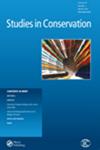德黑兰古列斯坦宫Mouze Makhsus博物馆画作储藏室中分离微生物的生物降解潜力研究
IF 0.8
4区 化学
0 ARCHAEOLOGY
引用次数: 2
摘要
摘要绘画是世界文化遗产的重要组成部分。它们由有机分子组成,如油、蜡、树胶、糖、多糖和蛋白质,可以支持各种微生物的生长。在本研究中,为了鉴定Mouze Makhsus储藏室中可能与画作变质有关的微生物群落,分离了在画作中定植的可培养细菌和真菌。分离的细菌和真菌的鉴定是通过形态学分析以及细菌的16srRNA基因和真菌的ITS基因组区的PCR扩增和DNA测序进行的。根据获得的细菌16S rRNA基因序列和真菌ITS区序列,采用邻居连接法构建了系统发育树。该研究还在体外评估了细菌和真菌分离株的纤维素分解活性。研究结果突出了在采样画作中定居的各种微生物群。基于培养的分析揭示了27个细菌和真菌分离株。检测到的真菌分为七个属,包括曲霉属、青霉属、枝孢属、链格孢属、弯孢属、毛霉菌属和Trametes属。大多数分离的细菌属于芽孢杆菌属,而分离的葡萄球菌、微球菌、Paenibacillus、Arthrobacter、Heyndrickxia、Priestia和Rathayibacter的程度较低。对纤维素酶产生的定性和定量评估表明,真菌分离物具有重要的纤维素酶活性,对绘画具有潜在的危险性。本文章由计算机程序翻译,如有差异,请以英文原文为准。
Study of Biodeterioration Potential of Microorganisms Isolated in the Paintings Storeroom of Mouze Makhsus Museum, Golestan Palace, Tehran
ABSTRACT Paintings are essential components of cultural heritage all over the world. They consist of organic molecules such as oils, waxes, gums, sugars, polysaccharides, and proteins that can support the growth of various microorganisms. In this study, in order to identify the microbial community possibly involved in deterioration of paintings in the storeroom of Mouze Makhsus, culturable bacteria and fungi colonizing the paintings were isolated. The identification of isolated bacteria and fungi was performed through morphological analyses and either PCR amplification and DNA sequencing of 16srRNA gene, for bacteria, and ITS genomic region, for fungi. Based on the obtained 16S rRNA gene sequence of bacteria and ITS region sequence of fungi, a phylogenetic tree was constructed using the Neighbor-Joining method. The study also evaluated, in vitro, the cellulolytic activity of the bacterial and fungal isolates. The results highlighted the diverse array of microbial groups colonizing the sampled paintings. Culture-based analyses revealed 27 isolates of bacteria and fungi. Detected fungi fell in seven genera including Aspergillus, Penicillium, Cladosporium, Alternaria, Curvularia, Chaetomium, and Trametes. The majority of isolated bacteria belong to Bacillus genus, whereas to a lesser extent Staphylococcus, Micrococcus, Paenibacillus, Arthrobacter, Heyndrickxia, Priestia, and Rathayibacter were isolated. Qualitative and quantitative assessment of cellulolytic enzyme production showed that the fungal isolates present important cellulolytic activity, and they are potentially dangerous to the paintings.
求助全文
通过发布文献求助,成功后即可免费获取论文全文。
去求助
来源期刊

Studies in Conservation
化学-分析化学
CiteScore
1.80
自引率
12.50%
发文量
73
审稿时长
>12 weeks
期刊介绍:
Studies in Conservation is the premier international peer-reviewed journal for the conservation of historic and artistic works. The intended readership includes the conservation professional in the broadest sense of the term: practising conservators of all types of object, conservation, heritage and museum scientists, collection or conservation managers, teachers and students of conservation, and academic researchers in the subject areas of arts, archaeology, the built heritage, materials history, art technological research and material culture.
Studies in Conservation publishes original work on a range of subjects including, but not limited to, examination methods for works of art, new research in the analysis of artistic materials, mechanisms of deterioration, advances in conservation practice, novel methods of treatment, conservation issues in display and storage, preventive conservation, issues of collection care, conservation history and ethics, and the history of materials and technological processes. Scientific content is not necessary, and the editors encourage the submission of practical articles, review papers, position papers on best practice and the philosophy and ethics of collecting and preservation, to help maintain the traditional balance of the journal. Whatever the subject matter, accounts of routine procedures are not accepted, except where these lead to results that are sufficiently novel and/or significant to be of general interest.
 求助内容:
求助内容: 应助结果提醒方式:
应助结果提醒方式:


